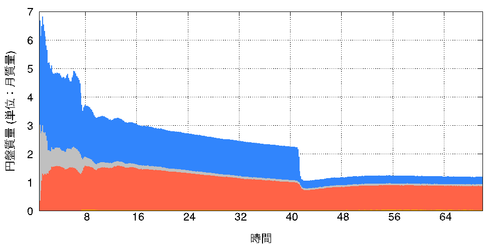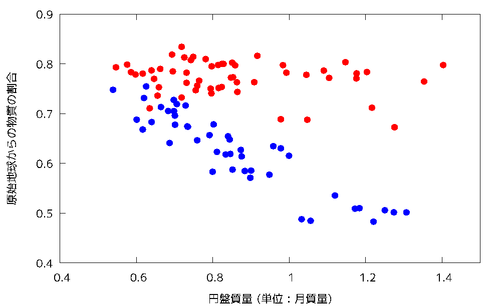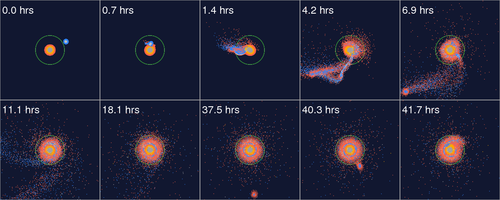Research Highlights
Terrestrial magma ocean origin of the Moon
The researchers carried out moon formation simulations based on the giant impact hypothesis. Unlike the standard modeling of the giant impact simulation, for the first time they conducted 3D simulations of the giant impact when the early Earth had a magma ocean on its surface. Their simulations clearly show that the presence of the magma ocean helps to form the moon, which originated from the Earth's material, solving the long-standing issue of giant impact simulations.
Animation: This animation shows the process in which the giant impact causes a large amount of material to be ejected from the proto Earth. Credit: Natsuki Hosono, Hirotaka Nakayama and 4D2U project.
How and when the Moon formed is still under debate. The giant impact hypothesis is the most widely accepted theory and assumes a mars-sized small planet impacted proto-Earth and triggered the formation of the current Moon. If it is possible to form the Moon which is composed of materials from the surface of proto-Earth, this will support the fact that the isotope ratios of the Apollo samples are almost identical to those of Earth's rock. However, the early modeling of giant impact simulations could not reproduce the Moon with the majority of its mass coming from the Earth. This is the so-called isotropic crisis.
Figure 1. Simulation of a giant impact. In this case, the surface of the proto-Earth is covered with a magma ocean. Red, orange, blue and gray colored points represent the magma ocean, mantle of the proto-Earth, that of the impactor, and iron cores, respectively. Credit: Natsuki et al, 2019
Here, they considered the situation in which the early Earth was covered with a magma ocean (liquid phase SiO2) and, for the first time, carried out giant impact simulations (Figure 1 and animation). Their simulations show that the material of the magma ocean could be the primary source of the Moon-forming disk, unlike the canonical model (Figures 2 and 3). The presence of the magma ocean on the proto-Earth is an important key ingredient to solve the isotropic crisis in the giant impact hypothesis.
 Figure 2. Time evolution of the mass components of the Moon-forming disk as a function of time. The colors are the same as those of figure 1. Natsuki et al, 2019
Figure 2. Time evolution of the mass components of the Moon-forming disk as a function of time. The colors are the same as those of figure 1. Natsuki et al, 2019
 Figure 3. The fraction of the Earth origin material in the Moon-forming disk as a function of the disk mass. This figure compiles both the cases with and without the magma ocean. Red and blue points are results of the runs with and without the magma ocean. The typical fraction of the Earth origin material in the runs with a magma ocean is ~80%, which is almost twice as much as the canonical giant impact simulations. Natsuki et al, 2019
Figure 3. The fraction of the Earth origin material in the Moon-forming disk as a function of the disk mass. This figure compiles both the cases with and without the magma ocean. Red and blue points are results of the runs with and without the magma ocean. The typical fraction of the Earth origin material in the runs with a magma ocean is ~80%, which is almost twice as much as the canonical giant impact simulations. Natsuki et al, 2019
While the presence of the magma ocean during Earth's evolution is currently a widely accepted idea, it has never been taken into consideration in giant impact simulations. This is because there is no good model of the magma ocean (say, equation of state) that is suitable to use in numerical simulations. Here they develop it and adopt a novel numerical scheme of hydrodynamics (DISPH) and a framework, which assists in the development of the particle simulator for the massively parallel environment (FDPS).
| Journal | Nature Geoscience |
| Tile of the paper | Terrestrial magma ocean origin of the Moon |
| Authors | Natsuki Hosono1,2, Shun-ichiro Karato3, Junichiro Makino4,2 and Takayuki R. Saitoh4,5 |
| Affiliations | 1) Yokohama Institute for Earth Sciences, Japan Agency for Marine-Earth Science and Technology, Yokohama, Kanagawa, Japan. 2) RIKEN Center for Computational Science, Kobe, Hyogo, Japan. 3) Department of Geology and Geophysics, Yale University, New Haven, CT, USA. 4) Department of Planetology, Kobe University, Kobe, Hyogo, Japan. 5) Earth-Life Science Institute, Tokyo Institute of Technology, Meguro-ku, Tokyo, Japan. |
| DOI | 10.1038/s41561-019-0354-2 |
| Online published date | 29 April 2019 |













